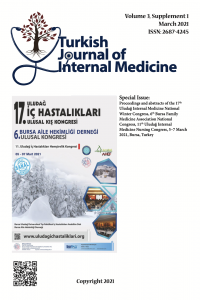Abstract
Supporting Institution
17. Uludağ İç Hastalıkları Ulusal Kış Kongresi ve 6. Bursa Aile Hekimliği Derneği Ulusal Kongresi ve 11. Uludağ İç Hastalıkları Hemşirelik Kongresi
Project Number
bildiri no 78
References
- Torres VE, Harris PC, Pirson Y. Autosomal dominant polycystic kidney disease. Lancet. 2007 Apr 14;369(9569):1287-1301. doi: 10.1016/S0140-6736(07)60601-1.
- Kalatharan V, Grewal G, Nash DM, Welk B, Sarma S, Pei Y, Garg AX. Stone prevalence in autosomal dominant polycystic kidney disease: A systematic review and meta-analysis. Can J Kidney Health Dis. 2020 Jul 4;7:1-19. doi: 10.1177/2054358120934628.
- Gaur P, Gedroyc W, Hill P. ADPKD-what the radiologist should know. Br J Radiol. 2019 Jun;92(1098):20190078. doi: 10.1259/bjr.20190078.
- Veser J, Özsoy M, Seitz C. Congenital and acquired diseases related to stone formation. Curr Opin Urol. 2018 Sep;28(5):414-9. doi: 10.1097/MOU.0000000000000522.
- Mallett A, Patel M, Tunnicliffe DJ, Rangan GK. KHA-CARI autosomal dominant polycystic kidney disease guideline: Management of renal stone disease. Semin Nephrol. 2015 Nov;35(6):603-6.e3. doi: 10.1016/j.semnephrol.2015.10.012.
- Ghata J, Cowley BD Jr. Polycystic kidney disease. Compr Physiol. 2017 Jun 18;7(3):945-75. doi: 10.1002/cphy.c160018.
- Mufti UB, Nalagatla SK. Nephrolithiasis in autosomal dominant polycystic kidney disease. J Endourol. 2010 Oct;24(10):1557-61. doi: 10.1089/end.2010.0093.
- Chapman AB, Devuyst O, Eckardt KU, Gansevoort RT, Harris T, Horie S, Kasiske BL, Odland D, Pei Y, Perrone RD, Pirson Y, Schrier RW, Torra R, Torres VE, Watnick T, Wheeler DC; Conference Participants. Autosomal-dominant polycystic kidney disease (ADPKD): executive summary from a Kidney Disease: Improving Global Outcomes (KDIGO) Controversies Conference. Kidney Int. 2015 Jul;88(1):17-27. doi: 10.1038/ki.2015.59.
- Grantham JJ. Clinical practice. Autosomal dominant polycystic kidney disease. N Engl J Med. 2008 Oct 2;359(14):1477-85. doi: 10.1056/NEJMcp0804458.
- Skolarikos A, Alivizatos G, de la Rosette J. Extracorporeal shock wave lithotripsy 25 years later: complications and their prevention. Eur Urol. 2006 Nov;50(5):981-90; discussion 990. doi: 10.1016/j.eururo.2006.01.045.
Polycystic Renal Disease Presented by Anuria and Nephrolithiasis Associated Progressive Kidney Damage: A Case Report
Abstract
Autosomal Dominant Polycystic Kidney Disease (ADPKD) is the most common inherited kidney disease. Kidney stones develop in 20-30% of patients with ADPKD.Hydronephrosis, which is the most valuable radiological finding in the diagnosis of stone-related postrenal insufficiency, may be difficult to differentiate from common cysts in ADPKD patients. When kidney dysfunction develops in ADPKD patients, Glomerular Filtration Rate (GFR) loss reaches an average of 4.4 to 5.9 mL / min per year. Faster deterioration in these patients requires investigation for prerenal factors such as dehydration that triggers acute kidney damage or stone-related postrenal factors. In ADPKD, stone-related postrenal obstruction should be considered in rapid GFR losses despite negative ultrasound report for hydronephrosis as there is frequent occurrence of kidney stones and the difficulty in detecting hydronephrosis with ultrasonography (US) in these patients. Here, we present a case with ADPKD whose renal functions rapidly deteriorated while under chronic follow-up and renal function markers returned to the basal levels with the treatment of the underlying cause.
Project Number
bildiri no 78
References
- Torres VE, Harris PC, Pirson Y. Autosomal dominant polycystic kidney disease. Lancet. 2007 Apr 14;369(9569):1287-1301. doi: 10.1016/S0140-6736(07)60601-1.
- Kalatharan V, Grewal G, Nash DM, Welk B, Sarma S, Pei Y, Garg AX. Stone prevalence in autosomal dominant polycystic kidney disease: A systematic review and meta-analysis. Can J Kidney Health Dis. 2020 Jul 4;7:1-19. doi: 10.1177/2054358120934628.
- Gaur P, Gedroyc W, Hill P. ADPKD-what the radiologist should know. Br J Radiol. 2019 Jun;92(1098):20190078. doi: 10.1259/bjr.20190078.
- Veser J, Özsoy M, Seitz C. Congenital and acquired diseases related to stone formation. Curr Opin Urol. 2018 Sep;28(5):414-9. doi: 10.1097/MOU.0000000000000522.
- Mallett A, Patel M, Tunnicliffe DJ, Rangan GK. KHA-CARI autosomal dominant polycystic kidney disease guideline: Management of renal stone disease. Semin Nephrol. 2015 Nov;35(6):603-6.e3. doi: 10.1016/j.semnephrol.2015.10.012.
- Ghata J, Cowley BD Jr. Polycystic kidney disease. Compr Physiol. 2017 Jun 18;7(3):945-75. doi: 10.1002/cphy.c160018.
- Mufti UB, Nalagatla SK. Nephrolithiasis in autosomal dominant polycystic kidney disease. J Endourol. 2010 Oct;24(10):1557-61. doi: 10.1089/end.2010.0093.
- Chapman AB, Devuyst O, Eckardt KU, Gansevoort RT, Harris T, Horie S, Kasiske BL, Odland D, Pei Y, Perrone RD, Pirson Y, Schrier RW, Torra R, Torres VE, Watnick T, Wheeler DC; Conference Participants. Autosomal-dominant polycystic kidney disease (ADPKD): executive summary from a Kidney Disease: Improving Global Outcomes (KDIGO) Controversies Conference. Kidney Int. 2015 Jul;88(1):17-27. doi: 10.1038/ki.2015.59.
- Grantham JJ. Clinical practice. Autosomal dominant polycystic kidney disease. N Engl J Med. 2008 Oct 2;359(14):1477-85. doi: 10.1056/NEJMcp0804458.
- Skolarikos A, Alivizatos G, de la Rosette J. Extracorporeal shock wave lithotripsy 25 years later: complications and their prevention. Eur Urol. 2006 Nov;50(5):981-90; discussion 990. doi: 10.1016/j.eururo.2006.01.045.
Details
| Primary Language | English |
|---|---|
| Subjects | Internal Diseases |
| Journal Section | Short Report |
| Authors | |
| Project Number | bildiri no 78 |
| Publication Date | March 7, 2021 |
| Submission Date | January 30, 2021 |
| Acceptance Date | March 6, 2021 |
| Published in Issue | Year 2021 Volume: 3 Issue: Supplement 1 |



